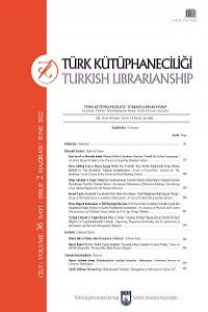Bilişsel Yapının ve İşlemlerin Bilgi Arama Davranışı Üzerine Etkisi
Bilgi Arama Davranışı, Bilişsel Yaklaşım, Bilişsel Yapı, Bilişsel İşlemler, Bilgi Erişim, İlgililik
The Impact of Cognitive Structure and Processeson Information Seeking
Information Seeking, Cognitive Approach, Cognitive Structure, Cognitive Process, Information Retrieval, Relevance,
___
- Allen,BryceL. (1991).Cognitive research in informationscience:Implicationsfor design.M.E.Williams (Yay. Haz.),Annual review of informationscience andtechnologyiçinde(Cilt 26,ss.1-37). New Jersey:American Society forInformationScience.
- Ausubel, D.P.(1963).Cognitive structure andthe facilitation of meaningfulverbal learning.Journal of Teacher Education,14, 217-221.
- Barnett,GeorgeA. ve Siegel G.(1988).Thediffusion ofcomputer assistedlegal research systems. Journal of theAmericanSociety for Information Science,39(4), 224-234.
- Barry, CarolL.veSchamberL. (1998).Users' criteria for relevanceevaluation:A cross-situationalcomparison. InformationProcessingandManagement, 34(2/3),219
- Bates, M.J. (1989). Thedesignofbrowsing and berrypickingtechniquesfor the onlinesearchinterface. Online Review,13, 407-424.
- Belkin,N.J.,Oddy R.N.ve BrooksH.M. (1982a). ASK for informationretrieval: PartI. background andtheory. Journalof Documentation, 38(2),61-71.
- Belkin,N.J.,Oddy R.N.ve BrooksH.M.(1982b). ASKfor informationretrieval: Part II.result of designstudy. Journal of Documentation, 38(3), 145-164.
- Borgman,Christine L.(1986).The user'smentalmodel of aninformationretrieval system: An experimentona prototype onlinecatalog.International Journalof Man-MachineStudies,24(1),47-64.
- Bruce, HarryW.(1994). A cognitiveview of thesituationaldynamismof user centered relevanceestimation.Journal of the AmericanSocietyfor InformationScience,45(3), 142-148.
- Burnkrant,R. E. (1976). A motivationalmodel of information-processing intensity. Journal ofConsumer Research, 3,21-30.
- Cosijn,E. ve Ingwersen,P.(2000). Dimensions of relevance. Information ProcessingandManagement,36,533-550.
- Cuadra, C.A.veKatter,R.V.(1967).Openingthe black boxof relevance. Journal of Documentation, 23(4),291-303.
- Das, J.P.,Kirby, J.R. ve Jarman, R.F.(1979).Simultaneousand sequential cognitive processes. NewYork:Academic Press.
- Davidson,D. Theeffect of individual differences cognitivestyle on judgments of documentrelevance.Journalof the AmericanSocietyfor InformationScience,28,273-184.
- Dervin,B. (1983). An overview of sensemaking research,concepts,methodsand resultsto date. Seattle,WA: Schoolof Communication,Universityof Washington.
- Dervin,B. veNilan, M.(1986). Informationneedsanduses.M.E. Williams (Yay. Haz.), Annual Review of InformationScience andTechnology içinde(Cilt 21,ss.3-33). White Plains,NY:Knowledge Industry Publications.
- Doyle,Lauren B. (1963). Isrelevance anadequatecriterionin retrievalsystem evaluation?HP Luhn (Yay.Haz.),Automation andscientific communication. 26thAnnual Meeting of the AmericanDocumentation Institute,Washington,D.C.'de sunulankısa bildiri.
- Driscoll,Marcy Perkins.(1993). Psychology oflearningfor instruction: Learning andinstructionaltechnology. Boston: Allyn& Bacon.
- Dumais, SusanT.ve LandauerT.K. (1984).Describingcategories of objectsfor menuretrieval systems.BehaviourResearch Methods,Instrumentsand Computers,16(2), 242-248.
- Fenichel,CarolHansen.(1981). Online searching:measures that discriminate amonguserswith different typesof experiences.Journal of theAmerican Society for InformationScience, 32(1),24-34.
- Glass,Arnold Lewis ve Holyoak,K. J.(1986). Cognition(2. bs.). New York: Random House.
- Halpern,Davidve Nilan, M.(1988). Astep toward shiftingtheresearch emphasis ininformationsciencefrom thesystem totheuser: anempirical investigation.C.L.Borgman veE.Y.H. Dai (Yay.Haz.), ASIS'88: InformationandTechnology: Planningfor the AmericanSocietyfor InformationScience51stAnnual Meeting:Cilt.25, ss. 169-176,Oct.23-27 Atlanta,GA. andMedford, NJ:Learned Information,Inc.
- Hancock,Micheline.(1987).Subjectsearching behaviour at thelibrary catalogue andattheshelves: Implicationsfor onlineinteractive catalogues.Journal of Documentation, 43(4), 303-321.
- Harter, StephenP.(1992). Psychologicalrelevanceandinformationscience. Journal of theAmericanSociety for InformationScience,43(October), 602-615.
- Howard,Helen. (1982).Measures that discriminateamongonlinesearcheswith different trainingandexperience.Online Review,6(4),315-327.
- Howard, JohnA.(1963). Marketing:Executive and buyer behavior.NewYork: ColumbiaUniversityPress.
- Ingwersen, Peter. (1987). Towardsa newresearch paradigmin information retrieval. IreneWormell (Yay. Haz.),Knowledgeengineering: Export systemsandinformationretrievaliçinde(ss.150-168). London: Taylor Graham.
- Janes, J. W.(1991). Relevancejudgmentsand the incrementalrepresentationof documentrepresentations. InformationProcessingandManagement, 26,6, 629-646.
- Kartzer, J.veSnyder, H. (1990).Toward a morerealisticassessment of information retrieval performance.Proceedings of theASIS.Washington,DC,80-85.
- Kuhlthau,CarolCollier. (1988). Developinga modelof thelibrary searchprocess: Cognitiveandaffective aspects.RQ, 28(2), 232-242.
- Kuhlthau,CarolCollier. (1991). Insidethesearchprocess:Informationseeking from theuser'sperspective.Journal of the AmericanSociety for InformationScience,42(5),361-371.
- Kuhlthau,CarolCollier. (1993). Aprinciple of uncertainty for information seeking.Journalof Documentation,49(4),339-355.
- Luger, GeorgeF.(1994). Cognitivescience:Thescience intelligentsystems. SandDiego:Academic Press.
- Mick, C.K., Lindsey G.N.veCallahanD. (1980).Toward usableuserstudies. Journal of the AmericanSociety for InformationScience, 31(5),347-365.
- MoreheadD.R.,Pejtersen A.M. RouseW.B.(1984). Thevalue ofinformation andcomputer aided informationseeking:Problem formulationand applicationto fictionretrieval.InformationProcessingandManagement, 20(5/6),583-601.
- Morgan,C.T.ve King,R.A.(1971). Introduction to psychology (3.bs.). New York: McGraw-Hill.
- Neisser,Ulric(1967).Cognitive psychology.(CenturyPsychologyDizisi) New Jersey:Prentice-Hall.
- Olşen, Şemsa (2000). Kullanıcınınbilgi seçiminde kararvermesini etkileyen bilişsel yapısıüzerinebirinceleme. (yayımlanmamışyüksek lisanstezi), Ankara: H.Ü. SosyalBilimler Enstitüsü.
- Park, T.K.(1993).The nature of relevancein ınformationretrieval:An empirical study.LibraryQuarterly, 63,318-351.
- Saracevic, Tefko. (1975). Relevance: A review of andaframeworkfor thethinking on thenotion in informationscience.Journalof the AmericanSociety for InformationScience,26(6),321-343.
- Saracevic, Tefko. (1996). Relevancereconsidered 96.Proceedingsof theSecond International Conferenceon Conceptions of LibraryandInformation Science:Integrationin Perspective, içindes.201-218. Copenhagen: The Royal School of Librarianship.
- Schamber,L. (1994). Relevanceandinformationbehavior.Annual Reviewof InformationScienceandTechnology,içindevol.29,s. 3-48. Medford, N. J: Information Today.
- Schamber, L.,Eisenberg,M.B.ve Nilan, M.S.(1990). A re-examinationof relevance:Toward adynamic,situationaldefinition.Information ProcessingandManagement,26(6),755-776.
- Shih, Hung-Pin(2004). Extended technology acceptance model of internet utilization behaviour. InformationandManagement, 41,6,719-729.
- Swanson,D.R.(1986).Subjective versus objective relevanceinbibliographic retrieval systems. LibraryQuarterly,56,389-398.
- Taylor, Robert S. (1968). Questionnegotiationandinformationseeking in libraries. College and Research Libraries, 29(May), 178-194.
- Uçak, NazanÖzenç.(1997). Bilgigereksinimivebilgi arama davranışı.Türk Kütüphaneciliği,11(4), 315-325.
- VanGigch,JohnP.(1991).Systemdesignmodelingandmetamodeling. NewYork: Plenum Press.
- Vigil,Peter J.(1983). Thepsychology of onlinesearching.Journalof American Societyfor InformationScience,34(4),281-287.
- Wilson,T(1981).On userstudies andinformationneeds. Journalof Documentation, 37(1),3-15.
- Wilson,T (1984). Thecognitiveapproach to informationseeking behaviour and informationuse. Social Science InformationStudies, 4, 197-204.
- Wilson, Tom veWalsh,C. Information behaviour: An inter-disciplinary perspective.16Kasım 2005tarihinde http://www.shef.ac.uk/~is/publications/prelims.htmladresindenerişildi.
- Whitmire,E.Disciplinary differences andundergraduates' information seekingbehaviour Journalof theAmericanSociety for Information Scienceand Technology. 53, 8,631-638.
- Yayın Aralığı: 4
- Başlangıç: 1952
- Yayıncı: Türk Kütüphaneciler Derneği
Açık Erişim Kavramı ve Gelişmekte Olan Bir Ülke Olarak Türkiye İçin Anlamı
İskenderiye Kütüphanesi: Antik Dünyanın Öğrenim Merkezi
E-Dönüşüme Giden Yolda Belge Yönetim ve İş Akış Sistemleri
A.eser BARANSEL, İ. İlker TABAK
Bilişsel Yapının ve İşlemlerin Bilgi Arama Davranışı Üzerine Etkisi
Nazan Özenç Uçak, Şemsa Olşen Güzeldere
Avrupa Birliği Sürecinde Türk Halk Kütüphaneleri: Nicel Değerlendirme
Avrupa Birliği Sürecinde Türk Halk Kütüphaneleri: Nicel Bir Değerlendirme
